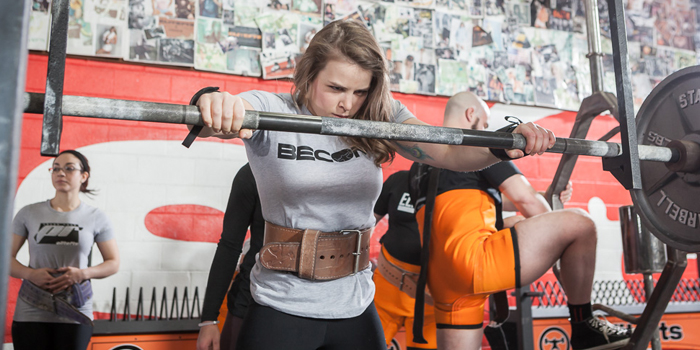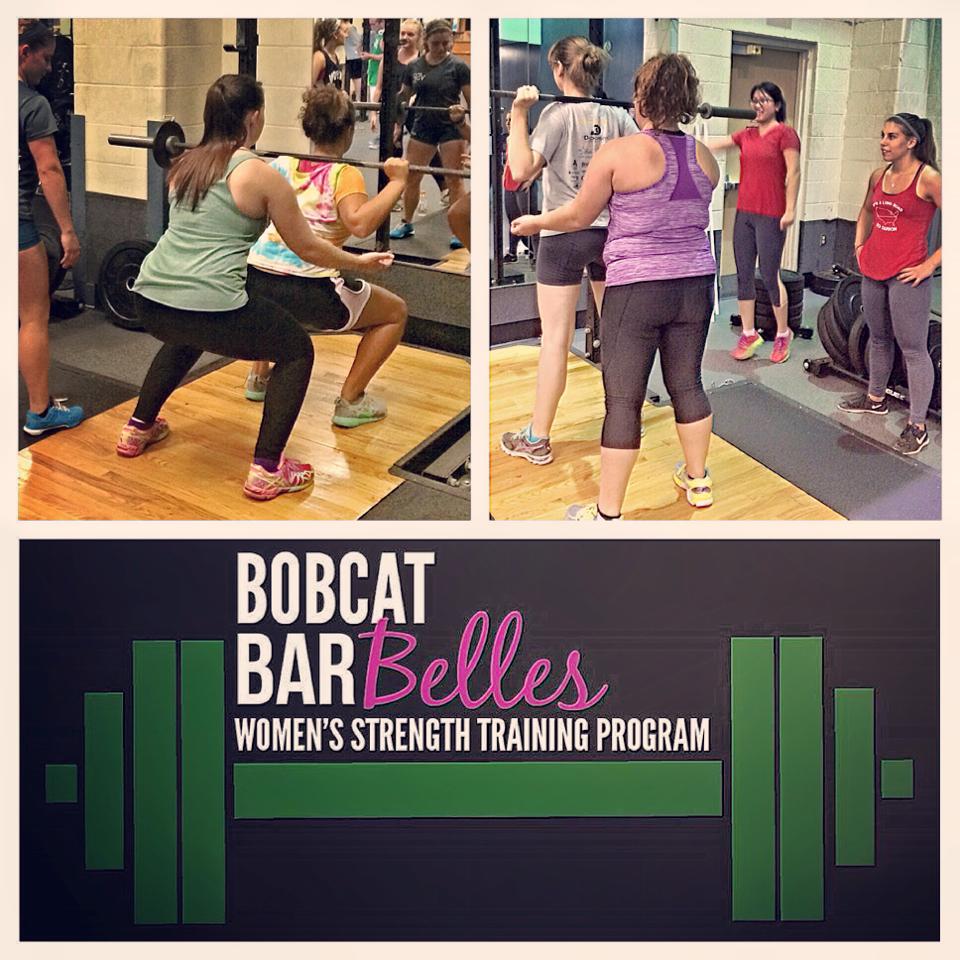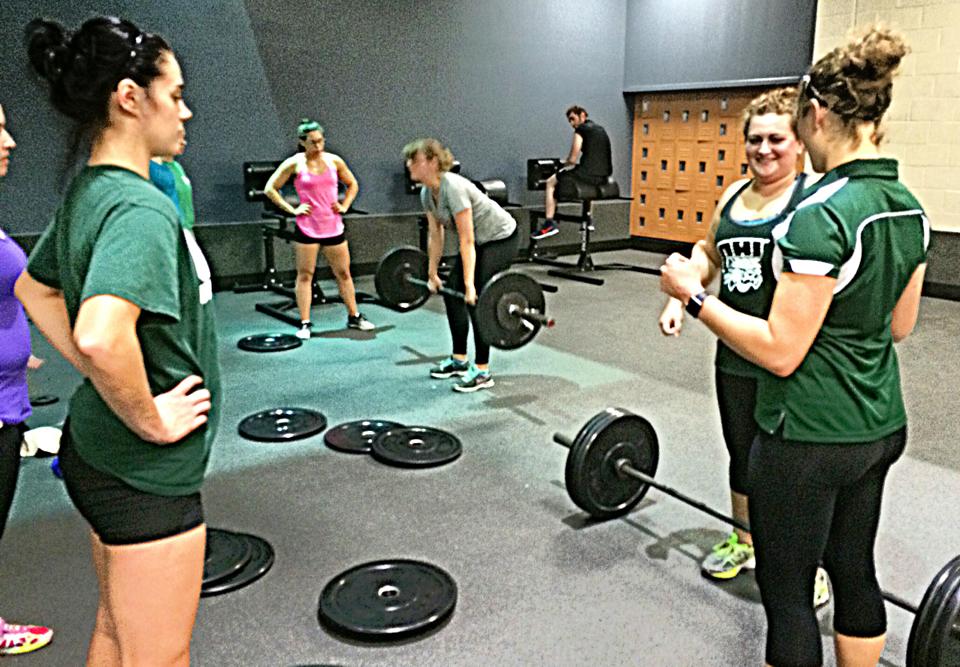
Squatting is as simple as sitting down and standing back up, right? For a few very gifted individuals, it may come that easily, but for the majority of people, learning to build a solid squat takes time and strategy.
I recently started our BarBelles Women’s Strength Training Program at Ohio University, where 35 college-age women are taking the fall semester to learn the core barbell movements (squat, bench press, deadlift and overhead press). We surveyed the women on their level of comfort and knowledge of the lifts before beginning the program, and 67 percent of them categorized themselves as having “very little to fair knowledge” of performing the squat. The other 33 percent identified on the far ends of the spectrum, having either zero knowledge or being very knowledgeable in the squat.
We used this assessment to determine the confidence level of the women because we wouldn’t know their actual skill level in performing the squat until we began working with them. After two weeks of working with the participants on technique, I can confidently say that they were all in the “beginner” level of lifting in skill in addition to their self-reported confidence level. I emphasize this because the purpose of this article is to focus on how we attacked the common weaknesses you may see when working with beginning lifters (specifically females). Also, keep in mind that while some of the women had an athletic background, our approach with them differed slightly from what I've used when working with competitive athletes in a strength and conditioning setting because of their athletic base and the amount of time we had to work with them (twice per week, working on each movement for two weeks).
Now that you have the background on the type of lifter we've been working with, I'll cover some of the common issues we saw in our group and how we addressed them.
RELATED: Bobcat BarBelles Kick Off 9-week Women's Strength Training Program
Movement Mindset
It’s been written about plenty of times before—movement “weak points” can always be broken down into mental, physical or technical issues. Oftentimes, when a beginning lifter struggles to perform an aspect of a movement, such as squatting down to full depth, the gut response could be “well they aren’t flexible enough.” In many cases, however, the lifter may just not be confident/comfortable in squatting down that low with a barbell on her back (especially if she's never had a barbell on her back before). When teaching a lifter a new movement, you should be watching right away through warm ups to see where she's comfortable and where she isn't. Ask some simple questions to find out about her previous experience performing the movement. For our group, many of the women weren’t even used to lifting in the weight room, so just making them more comfortable in that environment will translate to better technique and focus when performing the squat.
The way you coach will play a large role in this, especially when working in a group setting (we taught the lifters in groups of 6–12). Make sure that all the lifters feel like they have a role at all times. This will help them stay focused on the task at hand and make improvements and they won't worry about who is watching them or allow self-consciousness to creep in. Even if someone isn’t performing the movement, make sure that she is spotting, helping the coach (even just by giving simple cues) or working on drills to improve technique. Idle hands are the devil’s way of keeping you weak (or something like that).
Also, make sure that you’re giving positive feedback when working with beginners, particularly when they aren’t comfortable with the movement and/or the environment they’re in. However, that doesn’t mean baby them. Even the women in our groups who weren’t confident in the squat wanted honest, constructive feedback because they want to get better. You don’t do anyone any favors by only giving compliments without linking those compliments to ways that they can improve. Always follow a “great job” with “now we need to work on _____ for next time” and vice versa.
The drills and exercises that we had the lifters do in their warm ups and in between lifts were also designed in a way to build confidence. This will be covered in more detail below.
Technique Through Trial
Many of the lifters in our groups were learning squat technique for the first time. Because our time with them was limited, we needed to take advantage of every moment we had with them. When working with beginners, rather than spend too much time explaining technique while they stand there doing nothing, work those technique lessons into the warm up and throughout the session.
After performing a few dynamic warm-up movements, we had the lifters perform the following progression as part of their warm up:
- Body weight squat
- Body weight squat with PVC pipe on their back
- Wall squat with PVC pipe
Utilizing these movements as part of the warm up allows us to evaluate the motor ability and flexibility of the lifters as well as reinforce technique cues that we will use when squatting with the barbell. This is all done in a time efficient manner that also “greases the groove” for the movements and gets the lifters properly warmed up.
The cues we started teaching right off the bat were:
- Lats tight (by squeezing the PVC pipe/barbell and pulling the elbows down)
- Screw feet into floor (you can use physical cues to help them push against the outside of their shoes)
- Butt back first
- Knees out
- Chest up/head back
As we reinforced these cues with the PVC pipe and body weight during the warm up, it also worked as practice before heading into the weight room to take on the barbell. Once the lifters began working with the barbell, we continued to coach these cues and make adjustments to setup (i.e. stance width) if necessary. When teaching beginners a new barbell movement, it’s important to emphasize things like consistent setup right off the bat even with very light weights. We also kept the reps low and ran the group through multiple sets at each weight (starting with the empty bar). Doing five sets of 3–5 reps with the empty bar allows for more productive technique practice than quickly doing two sets of 12 reps.
As the lifters moved through the sets, some were able to continue to add weight to the barbell while others stayed at the same weight until they could perform certain aspects of technique correctly. It’s OK if technique isn't perfect, but when a lifter starts cutting squats really high or pitching forward dramatically on her toes, we took her to the side and worked on different drills to help correct this before adding more weight.
RECENT: What the Godfather Can Teach Us About Powerlifting
Our go-to drills to have the lifters perform in between sets to work on technique were:
- Kettlebell goblet squats
- Goblet/barbell box squats
- Squats with mini bands around knees
- Seated external rotations with mini bands around knees
These exercises allowed the women to work on technique corrections while still loading the movement and building strength. Don’t ever let technique issues prevent you from getting your lifters stronger. The key is to find ways to keep the technique in check while still providing some external resistance. We used these as teaching tools between sets with the barbell and recommended them as exercises to perform throughout the week.
Physical Focus
As mentioned above, while it is incredibly important to teach correct technique and provide mental encouragement, the physical aspects of squatting still need to be addressed! After all, let's remember that we're lifting weights here.
Muscular strength will obviously play a large role in performing the squat, but we won't be able to utilize that strength if there are serious flexibility or mobility issues putting the brakes on correct movement. We sent the following resource to our lifters so they could perform some of these drills in addition to our dynamic warm up (if necessary to correct an issue):
Once mobility and technique were addressed, we emphasized the importance of beginning to consistently perform the loaded movements listed in the technique section above as well as to be confident in progressively overloading the barbell squat as their technique improved.
Many of the women needed to develop additional specific strength in the glutes, upper back, hamstrings and abductors (everything always needs to be stronger, but these were areas that needed special attention). In addition to the squat variations that we covered, utilizing single leg, machine and special movements such as the glute ham raise throughout the week as part of their workouts will help build these areas and improve their barbell squat.
Because many of these women are performing these movements for the first time, we emphasized the following (initially) instead of overwhelming them with complicated program design:
- Consistency
- Balance
- Progressive overload
Once the lifters begin training consistently with a balanced arsenal of exercises and gain the confidence to progressively overload the movements, we can discuss more advanced types of programming. Getting the above components built into habit first will lay the foundation for future success.
The coaching methods above are designed to build a foundation for the beginner. If this foundation is built correctly, the more advanced training components can be plugged in without any problems. The following video is what we sent to our group of female lifters after their first two weeks of training. It might be helpful as a quick reference for some of the movements mentioned above:
Hopefully, this can be helpful in your own journey of working with clients, athletes and beginners in whatever realm of training you're involved in. There are additional aspects of coaching these groups that go beyond the scope of this article, but the above should give you some good ideas to get started. The goal was to provide some tools and how to use them rather than give an exact “beginner program” (think about the whole “teach a man to fish” analogy).
In my next article, I'll go deeper into some of the technique cueing and training differences we’ve seen that apply to women (versus men) in particular. This is an exciting time in strength sports and coaching. The interest in barbell training is growing, and women in particular are starting to see the potential for becoming not only strong but strong(her).













4 Comments